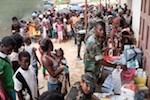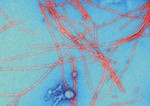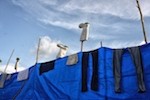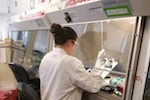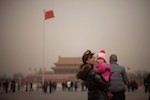Mathematician Lydia Bourouiba uses high-speed video to break down the anatomy of sneezes and coughs — and to understand infectious disease.
So, how do you get your research subjects to sneeze on cue?
“That's a question I get a lot,” says Lydia Bourouiba with an easy smile. The solution turns out to be surprisingly simple: just take a small, rod-shaped device, use it to tickle a subject's nostril for a few seconds, and — achoo!
For Bourouiba, a mathematician and fluid dynamicist, that sneeze is the pay-off. She and her team at the Massachusetts Institute of Technology (MIT) in Cambridge record the explosive aftermath in gross detail using one or sometimes two cameras running at thousands of frames per second. Played back in slow motion, the videos reveal a violent explosion of saliva and mucus spewing out of the mouth in sheets that break up into droplets, all suspended in a turbulent cloud.
The videos that Bourouiba has recorded in this way allow her to measure everything from the diameter of the droplets to their speed — data that help her to learn more about how these particles carry viruses and other pathogens to their next host. She has shown that sneeze and cough particles can travel the length of most rooms and can even move upwards into ventilation shafts — suggesting that microbes in the droplets could potentially spread farther and over longer periods of time than current theories suggest.
Ultimately, says Bourouiba, her goal with this work is to ground epidemiology and public health in physics and mathematics. When trying to keep diseases from running rampant, she says, “we want to be giving recommendations that are based on science that has been tested in the lab”. In practical terms, such insights could lead to maps showing the contamination risks in the vicinity of infected people, protective equipment optimized to shield hospital workers from specific kinds of germs, and better predictions of how diseases move through a population.
Bourouiba pursues this goal with the same energy and ambition that leads her to fill her leisure time with week-long bike trips, mountain climbing — she ascended Tanzania's Mount Kilimanjaro in 2011 — and winter camping at −20 °C. Although she is hardly the first researcher to use high-speed video to study fluid dynamics, she is the first to realize its potential in the respiratory field, says David Ku, a biofluid-mechanics researcher at Georgia Institute of Technology in Atlanta. Bourouiba's approach could be transformative in the field, says Ron Fouchier, a virologist at the Erasmus University Medical Center in Rotterdam, the Netherlands. “This kind of physics is absolutely needed to understand how transmission works.”
A fluid career
Bourouiba has been a natural explorer as far back as she can remember. As a child in France, she immersed herself in books about science and nature, including a biography of Albert Einstein. She soon fell in love with mathematics and physics, and made them her major subjects when she earned her undergraduate degree in France and Montreal, Canada.
But during her graduate work in fluid mechanics at Montreal's McGill University, as she focused on narrower and narrower theoretical questions about turbulent flows, Bourouiba began to feel the itch for something more. She had spent some of her early years in Algeria during the civil war of the 1990s, and vividly remembered the turmoil and misery that she had witnessed there. “We know what the worst is, we saw a lot of it,” she says. “But what can we as a species do to push that boundary of what we can achieve, in terms of making the world a better place?”

In her search for an answer, Bourouiba soon homed in on health and epidemiology. This was the mid-2000s, and emerging diseases were all over the news. Severe acute respiratory syndrome (SARS) had killed nearly 800 people around the world in 2003, polio was making a comeback and avian flu was jumping across to humans. Infectious diseases seemed to Bourouiba like the perfect way to combine all of her interests and expertise.
She was tentative at first. A career in fluid mechanics promised to be secure and certain, whereas a head-first dive into biology seemed like a huge risk. But one day, about halfway through her PhD, she was mulling this conundrum as she made her way up the wall at a rock-climbing gym. “So what?” Bourouiba suddenly said to herself as she reached for the next handhold. “You can't make decisions out of fear.”
Violent events
Having come so far, Bourouiba saw her fluid-dynamics PhD to completion in 2008. But from there she managed to land a postdoc appointment in mathematical epidemiology at York University in Toronto, Canada, where she started thinking about sneezes and coughs.
These 'violent expiratory events' (as one of Bourouiba's papers calls them) were assumed to be one of the main ways that respiratory diseases spread. But how, exactly? Epidemiological studies estimate how a disease is transmitted on the basis of people's movements and activities at the time they got infected. Did they contract the disease by direct, person-to-person contact, such as shaking someone's germ-covered hand, or from contaminated surfaces such as doorknobs? Was it through large droplets that make a short leap from one respiratory tract to another, or through smaller aerosol particles that are suspended in air and can travel farther before being inhaled? Or was the route some combination of these modes?
Such studies have helped researchers to work out that measles is typically spread by aerosols and that Ebola is transmitted mainly through direct contact with infected bodily fluids. But there is still a lot of uncertainty for many pathogens, which hampers the ability of public-health officials to control the spread of disease during outbreaks and to prepare for future ones. SARS, for example, is thought to spread mainly through close contact, yet the 2003 outbreak showed at least some evidence of airborne transmission1. And some researchers think that Ebola viruses might travel through air to some degree2.
At York, Bourouiba became convinced that these uncertainties could be reduced by pinning down some key details about the physics of sneezes and coughs that conventional disease-transmission models are missing.
In 2010, a postdoc appointment at MIT gave her a chance to start filling those gaps with hard data. Up to that point, she had worked only on theory — but now she plunged into experimental research, learning through trial and error the subtleties of high-speed video and lighting to capture a sneeze. “Mathematicians are often uncomfortable in a lab setting,” says John Bush, a fluid dynamicist who was her mentor at MIT. “Lydia really took to it.”
Suspended spray
One thing that Bourouiba particularly wanted to pin down was the size distribution of the droplets coming out of the mouth, because size affects how many microbes a droplet can carry and how far it can travel through the air.
For her first set of experiments, published in 2014, she wanted to look at the entire spray of droplets3. Bourouiba posted adverts around the MIT campus to recruit volunteers, and filmed the coughs and sneezes of about ten healthy people. After much tinkering with camera positions, backgrounds and lighting levels — at one point, the lights made the room uncomfortably hot for participants — Bourouiba captured videos that showed that the droplets were propelled out of the mouth in a turbulent, buoyant cloud. The cloud grew and slowed down as it pulled in air from the environment, lifting and carrying the droplets away from the sneezer.
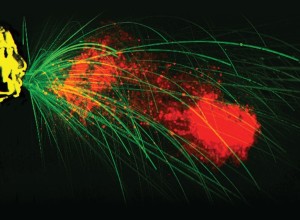
The video evidence contradicted conventional thinking about sneezes, which held that larger droplets would fall to the ground within 1–2 metres, and that only the smaller ones would stay aloft as airborne aerosols. Feeding her video evidence into her mathematical models, Bourouiba concluded that, thanks to the cloud dynamics, many of the larger droplets can travel up to 8 metres for a sneeze and 6 metres for a cough, depending on the environmental conditions, and stay suspended for up to 10 minutes — far enough and long enough to reach someone at the other end of a large room, not to mention the ceiling ventilation system.
That conclusion has implications for health-care workers, says James Hughes, an infectious-disease epidemiologist at Emory University in Atlanta. If a disease is thought to be transmitted within 1–2 metres, workers might assume that they are safe beyond that zone. “I think maybe we need to be a little bit more circumspect about that,” he says.
For Bourouiba's next set of experiments4, she zoomed in closer to the mouth to film a 150-millisecond-long sneeze. Videos taken from the side and top at up to 8,000 frames per second revealed that the fluid breaks up in steps, like a slow-motion explosion produced by Hollywood: the fluid emerges from the mouth in sheets, which are then punctured and form rings as they are stretched by the airflow. The rings fracture, leaving filaments. Little beads of fluid form on the filaments, which elongate and fragment to finally produce droplets.
Bourouiba was surprised to find so much happening to the fluid outside the mouth — it countered the prevailing assumption that droplets exit the mouth fully formed. To Gerardo Chowell, a mathematical epidemiologist at Georgia State University in Atlanta, this is an important finding because it means that droplet formation could be strongly influenced by environmental conditions such as humidity and temperature. And that could help to explain why some diseases, such as flu, tend to occur more frequently at certain times of the year, he adds, perhaps because the ambient conditions favour the spread and survival of certain microbes.
Bourouiba's research advances previous work measuring sneeze and cough droplet sizes, says Ku. Fluid particles can travel varying distances depending on a lot of different parameters, he says. “If I just tell you the size of the particles, I can't tell you where they're going to go. Her work actually shows where they go, with a real sneeze.”
The next level
A back injury last year has curtailed some of Bourouiba's more ambitious outdoor activities. But at work, she and her team are preparing to move into a newly built lab with a biosafety-level-2+ containment room, which will allow them to study the sneezes and coughs not just of healthy participants, but of people infected with colds and flu. In preparation for those studies, she has hired a microbiologist who can help the team to determine the microbial load in droplets and how long pathogens survive in the air or on surfaces while maintaining their ability to infect.
Answering this question will be crucial, says Hughes. “We need to learn more about the concentration of microbes in droplets of varying sizes and the infectious doses of a lot of these pathogens.” The containment room will also allow Bourouiba to control the airflow, temperature and humidity so that she can explore the behaviour of emitted droplets in environments that mimic hospitals, aeroplanes or the tropics.
Bourouiba's ultimate aim is to compile all of her data into a mathematical model that could be used by public-health officials to identify the most likely routes of transmission and how to reduce the risk of disease spread. The model would suggest, for example, whether the biggest risk of contamination is from the air or from surfaces, or how to change the airflow or temperature to minimize the risk in a hospital. It could predict whether a particular person is at high risk of being a 'superspreader' and should be quickly placed in a containment unit. During an emergency situation, when a new disease is spreading but it's not clear how, it might also help officials to identify the most dangerous environments, such as aeroplanes, so that people can avoid them. Then, as the first infected patients are tested and more is learned about the pathogen, those data could be incorporated into the model to refine the risk assessment.
Chowell, who models the spread of infectious diseases, hopes that Bourouiba's work could eventually be used to give diseases an 'airborne score'. Knowing that a pathogen is transmitted by airborne aerosols, say, 85% of the time could give public-health officials a better idea of how fast and far an outbreak will grow, compared with one that's just 5% airborne, he says. “Models require data, and I think the efforts of Bourouiba and others will help us better calibrate the design of these models, and this will have an impact on our ability to forecast disease spread in real time.”
That may depend on the disease, however. Work from Donald Milton, an environmental-health scientist at the University of Maryland School of Public Health in College Park, suggests that Bourouiba's approach may not have much impact on the study of influenza because people with flu rarely sneeze5. Studying people with the common cold might be more fruitful, he says, because they sneeze more often.
Milton also cautions that focusing on sneezes and coughs may not capture the whole story of respiratory-disease transmission. Breathing and talking are important to consider as well. He and his team have detected flu viral RNA in particles that were simply exhaled by patients, and they have even cultured viruses from such particles. Bourouiba says that she can study breathing emissions using her methods if they turn out to be a factor, but she first wants to study infected people to see which are the most important emissions to examine.
One occupational hazard for Bourouiba is that it's difficult to escape her work: whenever she hears a sneeze on a plane or in the classroom, she can't help thinking about the droplets flying through the air. There is not much she can do about that, but it does remind her why she became so fascinated with fluid mechanics when she was an undergraduate: fluids are everywhere.
Her videos might earn her the nickname of 'the sneeze lady', a student once warned her. But she says she doesn't mind. “If people get interested in the topic because of the humorous aspect, I have no problem with that.”
References
Yu, I. T. S. et al. N. Engl. J. Med. 350, 1731–1739 (2004).
Osterholm, M. T. et al. mBio 6, e00137–15 (2015).
Bourouiba, L., Dehandschoewercker, E. & Bush, J. W. M. J. Fluid Mech. 745, 537–563 (2014).
Scharfman, B. E., Techet, A. H., Bush, J. W. M. & Bourouiba, L. Exp. Fluids 57, 24 (2016).
Milton, D. K., Fabian, M. P., Cowling, B. J., Grantham, M. L. & McDevitt, J. J. PLoS Pathog. 9, e1003205 (2013).
Related links
Related links
Related links in Nature Research
Flu genomes trace H7N9's evolution and spread in China 2015-Mar-11
Models overestimate Ebola cases 2014-Nov-04
Progress stalled on coronavirus 2013-Sep-18
Related external links
Rights and permissions
About this article
Cite this article
Lok, C. The snot-spattered experiments that show how far sneezes really spread. Nature 534, 24–26 (2016). https://doi.org/10.1038/534024a
Published:
Issue Date:
DOI: https://doi.org/10.1038/534024a
This article is cited by
-
Visualization of Lagrangian fluid transport of a vortex ring based on time-resolved PIV
Journal of Visualization (2020)

